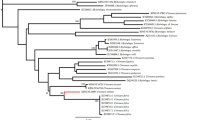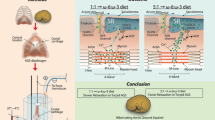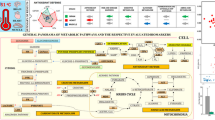Abstract
The carbohydrate and oxidative metabolism of the lateral musculature and of the liver was investigated in two Black Sea fishes. In Trachurus mediterraneus ponticus, muscular work leads to an intensification of glycolysis in the white muscle, and of oxidation in the red muscle as well as in the liver. Extirpation of the lateral red muscle provokes strong disturbances of muscle performance (without affecting the double character of contraction); the glycogen content of the white muscle decreases, while the lactate content of the liver increases. Hypoxic conditions lead, within a short time, to disturbances of the oxidative capacity in the red muscle and in the liver. In Gobius melanostomus, the effects of hypoxy or of muscular work are less pronounced. In isolated mixed muscle strips of Trachurus, contractions lead to a decrease of glycogen content in the red portion only. In isolated red muscle strips, the glycogen content rises during the incubation. These results are interpreted as supporting the hypothesis of a metabolic role of the lateral red muscle in fishes as energy source for the white muscle and as oxidative site for the catabolites of the latter.
Résumé
-
1.
Une asphyxie partielle de quelques minutes provoque, chez le Trachurus mediterraneus ponticus, un grand excès de lactate dans le muscle blanc et une baisse de la capacité d'oxydation du muscle rouge et du foie. Chez le Gobius melanostomus, elle provoque une grande baisse du glycogène hépatique.
-
2.
Un effort non-épuísant, provoqué par l'excitation électrique directe de la musculature latérale de Trachurus, engendro une intensification de la glycolyse dans le muscle blane et des processus oxydatifs dans le muscle rouge et dans le foie.
-
3.
L'ablation du muscle latéral rouge de Trachurus a comme conséquences un déréglage des mouvements de nage, une diminution consídérable de la capacité d'effort (sans que la partie lente de la contraction soit perdue), une baisse du glycogène du muscle blanc et une hausse du lactate hépatique.
-
4.
Les données présentées soutiennent l'hypothèse du rôle métabolique du muscle latéral rouge des poissons, source de matériel énergétique de la masse musculaire blanche et lieu d'oxydation de ses catabolites glycolytiques.
-
5.
On constate des différences dans le métabolisme d'effort entre Trachurus, Gobius et Cyprinus. Elles tiennent probablement du degré différent de développement du muscle rouge et du foie, des différences dans les réserves de glycogène et de graisses, de la résistance à l'hypoxie, ainsi que de l'écologie de ces espèces.
Similar content being viewed by others
Littérature citée
Barker, J. B. and W. H. Summerson: The colorimetric determination of lactic acid in biological material J. biol. Chem. 138, 535–554 (1941).
Black, E. C.: Hyperactivity as a lethal factor in fish. J. Fish. Res. Bd Can. 15, 573–586 (1958).
Bone, Q.: On the function of the two types of myotomal muscle fibre in elasmobranch fish. J. mar. biol. Ass. U.K. 46, 321–349 (1966).
Braekkan, O. R.: Function of the red muscle in fish. Nature, Lond. 178, 747–748 (1956).
Cordier, G.: Recherches sur le taux du glycogène cardiaque chez les poissons marins. Influence de l'anoxie. C. r. Séanc. Soc. Biol. 151, 1906–1908 (1957).
Huckabee, W. E.: Relationships of pyruvate and lactate during anaerobic metabolism II. Exercise and formation of O2-debt. J. clin. Invest. 37, 255–263 (1958).
Jonas, R. E. E. and E. Bilinski: Utilization of lipids by fish, III. J. Fish. Res. Bd Can. 21, 653–656 (1964).
Montgomery, R.: Determination of glycogen. Archs Biochem. Biophys. 67, 378–386 (1957).
Pora, E. A. et C. Wittenberger: Fixarea P32 în muschii crapului, în repaus si in activitate. Comunle Acad. Rep. pop. rom. 10, 1001–1007 (1960).
—, C. Wittenberger, I. V. Diaciuc et V. Toma: Modificări ale metabolismului global si tisular al crapului in urma unui efort locomotor. Studii Cerc. Biol. Cluj 13, 355–363 (1962).
Rindi, G. and G. Ferrari: A simple microcolorimetric method for the determination of pyruvate in 0.1 ml samples of blood. Experientia 12, 398 (1956).
Wittenberger, C.: Cercetări asupra fiziologiei muschiului striat la teleosteeni, VI. Comunle Acad. Rep. pop. rom. 12, 327–333 (1962).
— On the function of the lateral red muscle of teleost fishes. Revue roum. Biol. 12, 139–144 (1967).
— Alterations of the carbohydrate metabolism in trout, induced by effort and hypoxia. Rev. roum. Biol. 13, 131–137 (1968).
— and I. V. Diaciuc: Effort metabolism of lateral muscles in carp. J. Fish. Res. Bd Can. 22, 1397–1406 (1965).
— and E. Vîtcă: Variation of the glycogen content in the lateral muscles of the carp, during a work performed by isolated muscles and during starvation. Studia Univ. Babeş-Bolyai (Ser. Biol.) 2/1966, 117–123 (1966).
Author information
Authors and Affiliations
Additional information
Communicated by E. A. Pora, Cluj
Rights and permissions
About this article
Cite this article
Wittenberger, C. Biologie du chinchard de la Mer Noire (Trachurus mediterraneus ponticus). Marine Biol. 2, 1–4 (1968). https://doi.org/10.1007/BF00351630
Accepted:
Issue Date:
DOI: https://doi.org/10.1007/BF00351630




